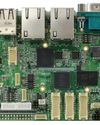Understanding Mesh Circuits How to Use and Calculate Them
Circuit Cellar
|October 2024
Microcontrollers and other digital systems concern mostly ones and zeros but when connections to the real word are needed it can get messy. Stuart writes about mesh analysis and how mesh circuits can be calculated and applied in practical scenarios.

When working with microcontrollers and other digital systems, we don't usually have to be concerned about anything but ones and zeros, right? But sometimes our MCU has to connect to the real world, and that can be messy. Sometimes we have to use that algebra that we couldn't see the need for in high school to make sure that we get the inputs or outputs we want and do it without damaging anything in the process. And in some cases, mesh analysis is how we handle that. I want to show you a few simple mesh circuits, and how they may be calculated and applied in practical scenarios. If you went to EE school, you probably saw this material in a fundamentals of electrical engineering course.
SIMPLE MESH CIRCUIT
Figure 1 shows a simple mesh circuit of three resistors. For a review of resistors, see my article "Getting Started with Resistors" in Circuit Cellar issue 382. Let's say that we need to calculate the voltage across the 2K resistor R2. This is fairly simple to do using series/parallel resistor calculations. R2 is 2K, R3 is 3K, so the value of R2 and R3 in parallel is 1.2K.
 The current through R1 plus the parallel combination of R2 and R3 is:
The current through R1 plus the parallel combination of R2 and R3 is:The voltage across the parallel combination of R2 and R3 is:
2.27ma x 1.2K = 2.73 v
So the current through R2 is 2.73V/2K = 1.36 ma.
This simple example illustrates some general principles of mesh circuits:
•The sum of the currents into a node (connection) is zero. The current flowing into the junction of R1, R2, and R3 has to equal the current flowing out. So the 2.27ma flowing in through R1 has to equal the two currents flowing out through R2 and R3. Note that in doing the calculations, you can (and usually do) assume that all currents are positive, flowing into the circuit. When you do the math, at least one will turn negative.
Bu hikaye Circuit Cellar dergisinin October 2024 baskısından alınmıştır.
Binlerce özenle seçilmiş premium hikayeye ve 9.000'den fazla dergi ve gazeteye erişmek için Magzter GOLD'a abone olun.
Zaten abone misiniz? Oturum aç
Circuit Cellar'den DAHA FAZLA HİKAYE

Circuit Cellar
The Future of Sensors in Safety Systems Sensing the Stop
How Magnetic Sensors Are Enabling the Next Generation of Braking Systems
5 mins
December 2025
Circuit Cellar
Alif Semiconductor Elevates Generative AI at the Edge with New Support for ExecuTorch Runtime in Its Ensemble MCUs
Alif Semiconductor, the leading global supplier of secure, connected, power efficient Artificial Intelligence and Machine Learning (AI/ML) microcontrollers (MCUs) and fusion processors, announced that developers can now use the ExecuTorch Runtime, a quantization extension of the popular PyTorch ML framework, for AI applications built to run on its Ensemble E4/E6/E8 series of MCUs and fusion processors.
1 min
December 2025

Circuit Cellar
Encrypted MQTT Protocol for Critical Sectors
Mechanisms, Challenges, and Best Practices
3 mins
December 2025

Circuit Cellar
Datasheet: Small Size, Big Power
Smaller Microcontrollers Bring New Possibilities
9 mins
December 2025

Circuit Cellar
Analog Devices Launches ADI Power Studio and New Web-Based Tools
Analog Devices, Inc. (ADI), a global semiconductor leader, announced the launch of ADI Power Studio, a comprehensive family of products that offers advanced modeling, component recommendations, and efficiency analysis with simulation.
1 mins
December 2025

Circuit Cellar
Compact IBR300 2.5" SBC Powered by NXP i.MX 93 from IBASE
IBASE Technology, Inc., a leading provider of rugged embedded computing platforms, announced the release of the IBR300, a 2.5\" RISC-based single board computer (SBC) powered by the NXP i.MX 93 processor with dualcore ARM Cortex-A55 (up to 1.7GHz) and a Cortex-M33 MCU.
1 min
December 2025

Circuit Cellar
Sensors in the Spotlight
The Next Decade of Embedded Sensor Systems
12 mins
December 2025

Circuit Cellar
Bob's Wrap Up
In Bob's last article with Circuit Cellar, he attempts to wrap up a career of more than 50 years as an embedded systems engineer and 14 years with Circuit Cellar. He looks at each of his 58 articles by category and provides some recommendations for his fellow engineers.
7 mins
December 2025

Circuit Cellar
Designing Embedded Software Architectures That Last
I've reviewed hundreds of firmware projects over the years, and one thing always stands out: the most successful projects have a clear, deliberate architecture.
10 mins
December 2025
Circuit Cellar
Broadcom Introduces Industry's First Wi-Fi 8 Silicon Ecosystem Powering the AI Era
Broadcom, Inc. unveiled the first Wi-Fi 8 silicon solutions for broadband wireless, targeting residential gateways, enterprise access points, and smart mobile clients.
1 mins
December 2025
Listen
Translate
Change font size

